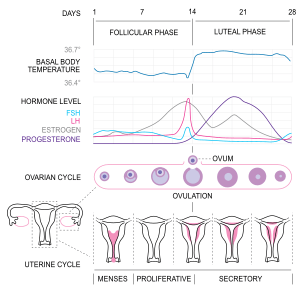Menstrual cycle facts for kids
The menstrual cycle is a process that adult women go through. The menstrual cycle for a woman will repeat every 28 days while they are not pregnant. During this time, the women's ovaries create a mature ovum (egg). Then the woman's body prepares for pregnancy by thickening the walls of the uterus. If the woman does not become pregnant during this time, the egg and the lining of the uterus come out of the woman's body during menstruation.
The menstrual cycle process is controlled by four major hormones: follicle stimulating hormone; luteinising hormone; estrogen; and progesterone. These hormones prepare the uterus to receive a fertilized egg and control its development.
The menstrual cycle has three stages: the Follicular stage, Ovulation, and the Luteal (or premenstrual) stage. The cycle will stop if the woman gets pregnant (if a fertilized egg implants itself into the lining of the uterus).
Follicular Stage
This stage is the start of the menstrual cycle, and is counted as day one of the cycle. This stage starts when the amount of progesterone and estrogen in a woman's blood drop. This causes the endometrium - the thick lining of the uterus - to leave the woman's body through menstruation. It will appear as bleeding from the vagina. This stage lasts from 4–6 days.
At the start of this stage, the pituitary gland will begin to release more follicle stimulating hormone. This will continue for 3-4 days. This makes several follicles grow in one of the ovaries. Each follicle contains an immature egg. These follicles create estrogen.
Usually, the amount of follicle stimulating hormone in the body peaks during the third or fourth day of menstruation. All but one of the follicles dies off. The one that is left releases even more estrogen. Once again, the lining of the uterus thickens. Near the end of the stage, a woman's estrogen levels peak. This causes the pituitary gland to release luteinising hormone, which also peaks at this time.
Ovulation
Ovulation happens roughly every 14 days. This is when the mature egg is released into the fallopian tube ready for fertilisation.
Ovulation happens if there is both a rise in estrogen and a peak in luteinising hormone at the end of the follicular stage. The rising levels of luteinising hormone make the ovum mature. The follicle that contains the ovum swells and breaks open. (In the next stage, the leftover cells of the follicle turn into an important structure called the corpus luteum.) The egg is released into the Fallopian tube.
During ovulation, a woman's body temperature is usually about 0.5 degrees Celsius over normal.
Luteal Stage
The follicle cells that used to hold the ovum now release progesterone into the body. This causes the endometrium to get even thicker.
If an ovum is fertilized, it happens during this step.
If fertilized
If the ovum is fertilized during ovulation, it will become a zygote. It will start to copy itself over and over again through mitosis. It will also move from the ovarian duct into the uterus. The levels of estrogen and progesterone in the body remain high. The zygote grows into an embryo and implants itself into the endometrium tissue of the uterus. This forms a placenta, which starts to mature.
After fertilization, the menstrual cycle stops so the embryo can continue to mature for the next 9 months. Progesterone and estrogen levels will stay high until the fetus is ready to be birthed.
Eventually, after giving birth, a woman's menstrual cycle will return to the way it was before she got pregnant.
If not fertilized
Until around day 22, estrogen levels increase a little. However, after day 22, the corpus luteum stops making progesterone, and the levels of both progesterone and estrogen in the body start to drop. The amount of progesterone and estrogen in the body are at their lowest around the 28th day of the menstrual cycle. Then the cycle begins again.
See also
 In Spanish: Ciclo sexual femenino para niños
In Spanish: Ciclo sexual femenino para niños



